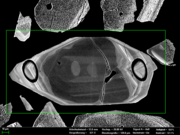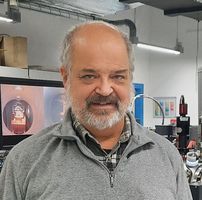The Potsdam Ion Microprobe (SIMS) User Facility
Section 3.1 of the Helmholtz Zentrum Potsdam operates a fully equipped, large geometry SIMS instrument, which is supported by a comprehensive spectrum of peripheral instrumentation. The SIMS laboratory is an open user facility intended to support the needs of the global geochemical community. Scientists from Europe and beyond are invited to contact us to discuss possibilities for collaboration. We strive to provide top-quality analytical data in an as rapid and uncomplicated means as possible.
SIMS Basics

Ion microprobes, also known as secondary ion mass spectrometers (SIMS), use a finely focused ion beam to probe a selected sample domain. A small percentage of the material sputtered from the polished surface of the sample is ionized, and these ions are accelerated into a mass spectrometer where they are separated according to their mass-over-charge ratio. An important characteristic of SIMS is its high sensitivity compared to other microbeam sampling techniques: the ability to count individual ions results in detection limits in the parts-per-billion range for many elements. Also the fact that ions derived from the sample are separated by their mass-over-charge ratio allows isotopic analyses to be performed on test portion masses that can be as small as 200 picograms.
Ion microprobes offer six modes of operation for geoscience applications:
Isotopic Analyses: Our 1280-HR instrument provides an analytical repeatability down to below 0.2‰ (1sd) for many major elements in a variety of crystalline matrices.
Trace Element Anlayses: For most elements our instrument has a limit of detection at or below 100 ng/g.
Geochronology: The 1280-HR can measure the U-Pb systematics on both zircon and on other suitable phases. Such analyses are a combination of both isotopic and trace element analyses.
Imaging: The Potsdam 1280-HR can provide element distribution maps with spatial resolutions reaching down to 2 µm.
Depth Profiling: Depth resolution on the Cameca 1280 is mainly limited by a sample´s surface polish. Typically we are able to quantify diffusion profiles with a resolution of approximately 20 nm.
Particle Search: Automated software will allow many millions of dust particles to be search in a single session looking for specific grains that have anomalous isotopic signatures or elevated trace element contents. This approach is particularly of use for environmental monitoring.

